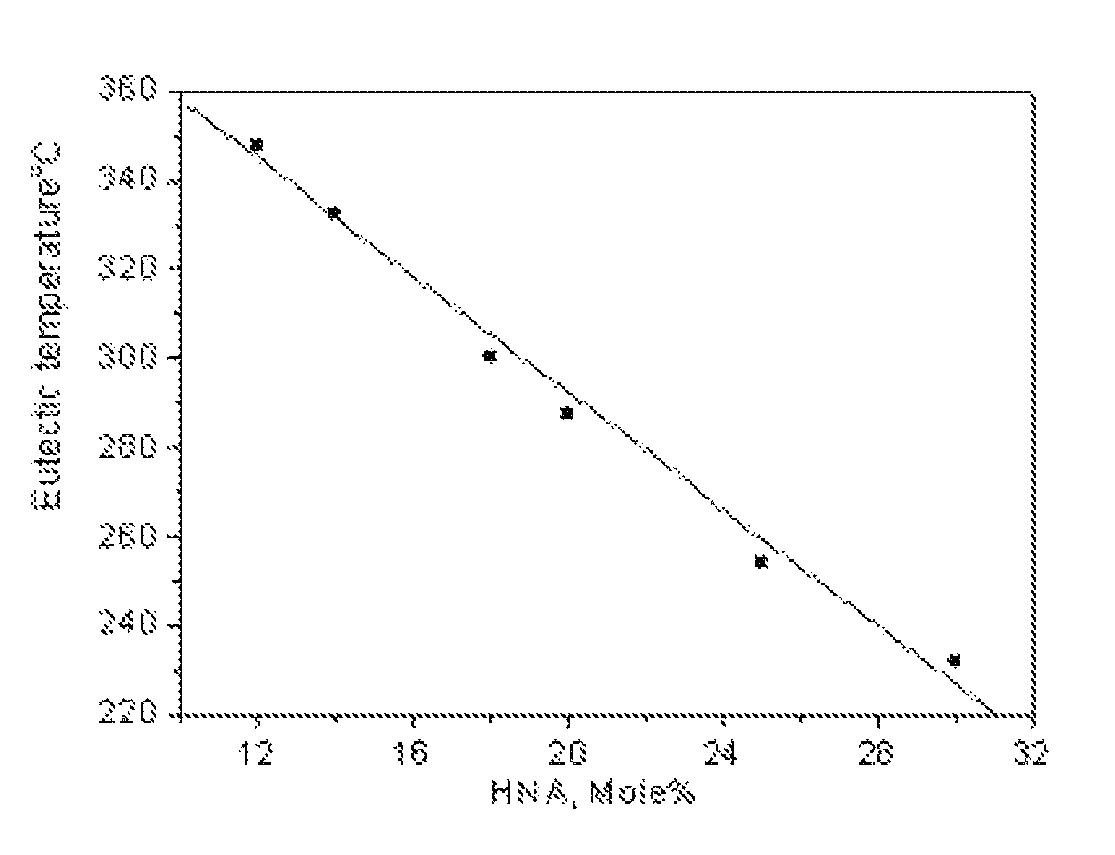Liquid crystalline polyester compositions
a technology of polyester compositions and liquid crystals, which is applied in the direction of liquid crystal compositions, chemical instruments and processes, etc., can solve the problems of insufficient melting temperature of tlcp actually made, and inability to expect high hd
- Summary
- Abstract
- Description
- Claims
- Application Information
AI Technical Summary
Benefits of technology
Problems solved by technology
Method used
Image
Examples
examples 1-4
[0042]For this series of TLCPs, the mole percent of HNA is 12%, and the compositions of this series are listed in Table 1. The preparation of the TLCP of Example 2 was chosen to describe the synthesis process. The amounts of monomers and acetic anhydride used for the synthesis of the polymer of Example 2 are shown below:
[0043]
p-hydroxybenzoic acid4475.09 g6-hydroxy-2-naphthoic acid1219.41 gterephthalic acid1255.94 ghydroquinone832.43 gacetic anhydride5788.50 gpotassium acetate2 g
[0044]A 30-L stainless reactor was utilized for acetylation and polymerization. The reactor was equipped with a stirrer and a unit for controlling agitator speed and monitoring torque. The reactor was further equipped with a vertical column for reflux of acetic acid, which was packed with Rasching rings and connected to a condenser and a receiver. A nitrogen source was connected to the reactor though a valve to maintain nitrogen purge during the reaction. A vacuum pump was provided to build molar mass in the...
examples 5-12
[0048]The TLCPs of this series contain 14 mole % HNA. The preparation process is similar to Examples 1-4, except that the temperature was set at 360-370° C. and the torque was required to reach 1.65-1.70 A at the end of polymerization. The composition and melting point of this series are listed in Table 1.
examples 13-21
[0049]The TLCPs of this series contain 18 mole % HNA. The preparation process is similar to Examples 1-4, except that the temperature was set at 330-355° C. and the torque was required to reach 1.40-1.45 A at the end of polymerization. The composition and melting point of this series are listed in Table 1.
PUM
| Property | Measurement | Unit |
|---|---|---|
| melting point | aaaaa | aaaaa |
| melting point | aaaaa | aaaaa |
| temperature | aaaaa | aaaaa |
Abstract
Description
Claims
Application Information
 Login to View More
Login to View More - R&D
- Intellectual Property
- Life Sciences
- Materials
- Tech Scout
- Unparalleled Data Quality
- Higher Quality Content
- 60% Fewer Hallucinations
Browse by: Latest US Patents, China's latest patents, Technical Efficacy Thesaurus, Application Domain, Technology Topic, Popular Technical Reports.
© 2025 PatSnap. All rights reserved.Legal|Privacy policy|Modern Slavery Act Transparency Statement|Sitemap|About US| Contact US: help@patsnap.com



